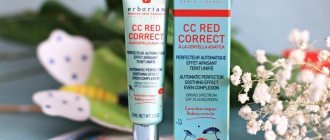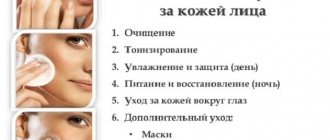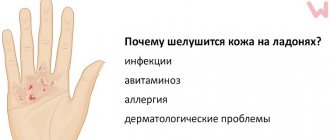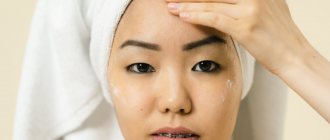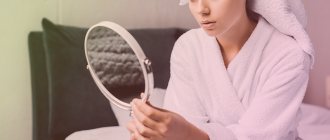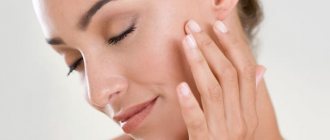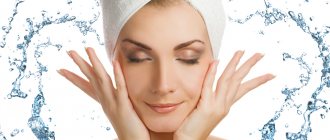First of all, let's clarify the symptoms. Peeling on the fingers or feet means dry skin, the formation of superficial blisters, and lamellar detachment of the skin.
Often, red, “tight” skin is visible under the peeling top layer. As part of self-medication, parents often resort to ointments, which gives a short-term improvement, but within 24 hours the child’s condition worsens again.
As with any symptom, we recommend making an appointment with a dermatologist rather than treating yourself. There are many diseases and ways to treat them.
Similar symptoms give:
- atopic dermatitis; - contact dermatitis; - eczema; - exfoliative keratolysis; - mycosis; - endocrine diseases; - allergic reactions; — lack of vitamins A and E; - incorrectly selected clothes; — violation of hygiene; — fungal diseases; - and many more reasons, with different tactics for their treatment.
Why is this happening
Peeling skin in a child is not uncommon. In childhood, the thickness of the skin is 1.5-3 times less than in an adult. The stratum corneum is also thinner. The structure of the skin itself is loose, which makes it more extensible (a necessary property during active growth).
But the downside of skin extensibility is insufficient keratinization of the stratum corneum, which performs the protective functions of the body. As a result, the child's skin is easily vulnerable and prone to inflammation and peeling.
Treating with ointments without a doctor’s prescription is dangerous
In childhood, the skin participates in the respiratory functions of a child to a greater extent than in an adult. Let’s also remember about the increased blood supply to the child’s skin and the general sensitivity of the child’s skin.
Ointments have a cumulative effect, and it is impossible to say exactly how the use of a number of medications will affect the child’s health in the future. Let us remind you once again - do not self-diagnose or self-medicate.
The only universal recommendation
Often the cause of peeling lies in household irritants (chemicals, plasticine, slimes, paints, household soap, PVA glue). If you notice peeling in your child, along with making an appointment with the doctor, limit your child's contact with the sources described above.
But it is important to understand that limiting contact with possible irritants alone in the treatment of “advanced pathology” is not enough - the skin barrier is already broken and requires restoration (including using physiotherapy).
Rules for caring for dry baby skin
Caring for a child’s skin during the day consists of several stages: washing the face, washing hands, washing intimate areas after each bowel movement, and bathing.
It is permissible to bathe a baby every day, as it not only cleanses the skin, but also calms the child, strengthens him, awakens his appetite, improves tactile and emotional skills, and improves psychological contact with parents. One of the mistakes parents make is bathing their child for a long time in a bath with potassium permanganate. Such bathing dries out the skin and is not advisable to use. Contraindications for water procedures are high body temperature and the presence of purulent-inflammatory diseases or open wounds on the body.
Bathing water should be soft and, if necessary, filtered. The water temperature should also not be high; it is optimal if it is 34-37° C. In order not to damage the protective hydrolipidic layer of the baby’s skin, it is not recommended to use bathing products every day. Pay attention to special products for babies that have delicate formulas and have been tested by pediatricians and dermatologists.
LIPIKAR GEL LAVANT
Soothing shower gel with protective properties
Soothes the skin, thanks to the action of Niacinamide and the lipid-restoring properties of Shea Butter, helps restore the skin's protective barrier. Suitable for cleansing the skin of the face and body, does not irritate the eyes.
719 rub. more details
This gel can also be used to cleanse babies' heads and for daily intimate hygiene when changing diapers. Washing should be as gentle as possible; it is not recommended to use washcloths made of rough materials.
After bathing, dry the body and apply a moisturizer. The towel should not be hard, you should not rub the baby’s skin too much, it is better to gently blot away excess moisture. You can use a terry bathrobe. During the first 3-5 minutes after bathing, while the skin is still damp, it is advisable to apply a moisturizer. You can use Lipikar Lait milk . It has a rich formula based on cold cream - a classic combination of protective lipids, enriched with Shea butter (10%) to restore the lipid barrier. Suitable for very dry skin of children and adults. And niacinamide provides long-lasting comfort to even the driest, most delicate and sensitive skin.
Create a favorable microclimate in the room where the child is. The air should not be dry, the temperature should not be higher than 18-22°C. Monitor the humidity, ideally if it fluctuates in the range of 40-70%. To maintain humidity, you can purchase a humidifier. During the heating season, it is necessary to shield the batteries; you can cover them with a wet towel to evaporate moisture.
Choose clothes made of cotton fabric, it breathes well and absorbs excess sweat well. Give air baths while changing diapers. When walking, do not wrap your baby tightly to avoid sweating.
During the summer, avoid going out in the sun during the hottest hours, from 11 a.m. to 4 p.m., or when the ultraviolet index is above 4 (just check this indicator in the Weather app on your smartphone or almost any website to determine the weather forecast). Be sure to wear a Panama hat or a hat for your child to protect from the sun; on the beach, it is better for your child to wear a closed swimsuit or T-shirt. Do not neglect sunscreens; choose them according to the child’s age. Be sure to reapply the cream every few hours according to your child's skin type and sun exposure that day. When you return home, wash off any remaining sunscreen and apply moisturizing milk to your skin. For mild sunburn or redness of the skin, you can use:
CICAPLAST BAUME B5
Multi-regenerating and healing product for baby skin
Due to its rich, nourishing texture, it protects the skin and creates a barrier that prevents bacteria from reaching the surface. Panthenol in the composition promotes the healing of irritated skin.
654 rub. more details
Causes of peeling hand skin
All causes of dryness and discomfort can be divided into everyday and pathological. At home, it helps to restore the lipid balance of the skin with the help of moisturizing creams, nourishing hand masks and other cosmetic products. If the cause is pathological, complex treatment will be required.
Household
Causes of hydrolipid imbalance and peeling of the skin on the palms and fingers:
- intense solar radiation - UV rays can destroy collagen and elastin in the deep layers of the skin;
- hard water, aggressive alkaline pH soap - surfactants destroy the lipid membrane of the skin;
- dry air – those with sensitive skin suffer from dryness and flaking during the heating season without a humidifier;
- hot baths – prolonged bathing destroys the secretion of the sebaceous glands.
Antiseptics and sanitizers with an alcohol content of 60% or more also affect the condition of the skin of the hands. At lower concentrations they are ineffective, but such ethanol content destroys the lipid protective layer of the epidermis. Regular use of antiseptics provokes peeling, redness, tightness and discomfort.
It is enough to choose soap with a neutral pH, a natural nourishing cream and normalize the microclimate to get rid of discomfort. And to protect against bacteria, choose an antiseptic with panthenol, plant extracts and essential oils.
Pathological
In dermatology, dryness and redness of the hands are a symptom of many skin diseases, but can also indicate disorders of other body systems:
- atopic dermatitis – inflammatory-allergic lesion;
- ichthyosis - dermatosis with a violation of the keratinization process;
- psoriasis is an autoimmune non-infectious disease;
- keratosis pilaris, “goose bumps” - affects the outer side of the palm with hair follicles.
Peeling of the hands can accompany diseases of the thyroid gland and gastrointestinal tract. A separate category is the psychosomatics of redness and itching of the skin of the hands. Therefore, differential diagnosis is carried out only by a qualified, experienced doctor who is able to correctly interpret the body’s signals.
Contact a specialist if the problem disrupts your usual rhythm of life, interferes with sleep, or the condition of your hands does not improve after taking minimal measures. It is especially important to get advice as soon as possible if the symptoms intensify and the dryness is accompanied by redness, the appearance of ulcers, inflammation, and blisters.
Advantages of the Morozko® children's winter series
All products included in the Morozko® line are hypoallergenic and safe. They were developed by domestic specialists taking into account the characteristics of harsh Russian weather conditions and are designed specifically to protect delicate children's skin from them. These products contain allantoin, chamomile extract, vitamins A, E and F. Natural ingredients carefully care for the baby’s skin, restore its natural strength, softness and elasticity, and restore the protective barrier.
For the care of thin facial skin, which is susceptible to frostbite and chapping in winter, the Rosy Cheeks® cream is intended. It creates a protective film on the surface of the skin that prevents the evaporation of water molecules, which means it will protect the face from the prickly wind and cold. A special children's hygienic lipstick Morozko® based on natural oils and wax has been developed for a child's lips, which effectively nourishes the lips and protects them from the cold wind.
Hand cream Mittens® will protect the skin from the effects of low temperatures, melted snow and ice water, and will also gently soften and soothe irritated and dry skin on a child’s hands, heal pimples and cracks and prevent possible drying out.
Morozko® universal cream is ideal for skin with severe dryness. It is made on the basis of reverse emulsion, has a high fat content and does not freeze even in severe frosts below 20⁰C. In addition, the cream perfectly eliminates dryness and irritation of the skin caused by water and detergents.
1Lukushkina E.F., Baskakova E.Yu. Skin is a barometer of health. Preventive and therapeutic role of emollients // RMZh. 2016. No. 18. pp. 1246-1252.
Features of children's skin
Regardless of the location of the body area, the skin of a child, like an adult, consists of three layers:
- epidermis - outer, very thin and actively growing layer;
- dermis – located under the outer layer;
- subcutaneous fat is especially developed in newborns and begins to form at the 5th month of intrauterine development.
Epidermis is the upper (horny) layer. In newborns it is very thin, but prone to rapid division and regeneration. Due to its immaturity, the outer layer is easily wounded and prone to penetration and spread of infection.
The middle layer, the skin itself, contains sebaceous and sweat glands, which are already quite well developed in utero and produce the lubricant that coats the baby at birth. The dermis also contains a well-developed network of blood vessels that ensure the function of skin respiration and metabolism.
In the child’s dermis there are cells responsible for immunity to allergens, so manifestations of allergic reactions occur on the skin.
The subcutaneous fat layer is well developed in newborns, but differs in its structure in different parts of the body. It is the fat layer that ensures high heat production in children.
What to do to prevent your child's skin from drying out
Preventive measures against dry skin:
- regular care;
- drinking regularly;
- balanced diet with sufficient vitamins;
- use of special soft care products tested by pediatricians and dermatologists.
Baby bathing and care products are marked on the packaging: “suitable for the use/care of the skin of infants and children”, “suitable for children” or the like. Plus, as a rule, the production of children's products is subject to higher requirements for the safety of formulas and stricter selection of components included in the formula.
How to treat dry, rough skin?
Dry and rough skin has many causes, and therefore treatment may vary depending on the age of the baby and the severity of the condition. Can be used:
- Topical moisturizing, anti-inflammatory ointments, creams, for conditions such as eczema, psoriasis and milk crusts, they provide relief from itching and prevent dry skin. These topical creams and ointments address the fundamental problem of dry skin.
- A moisturizing lotion is prescribed by a doctor for daily use, depending on the intensity of the child’s dry skin.
- Liquid dressings are prescribed for children with severely cracked and bleeding skin. Before use, the affected skin is washed and dried. A layer of liquid is then applied to the skin using the brush applicator included in the bottle. The first layer dries, after which the second layer is applied. The liquid forms a transparent coating and protects the leather from cracking. The liquid dressing used is waterproof and lasts for a week. Once the skin underneath has healed, the hardened liquid bandage will peel off on its own.
The child experiences relief from the treatment. All drugs are selected strictly individually.
